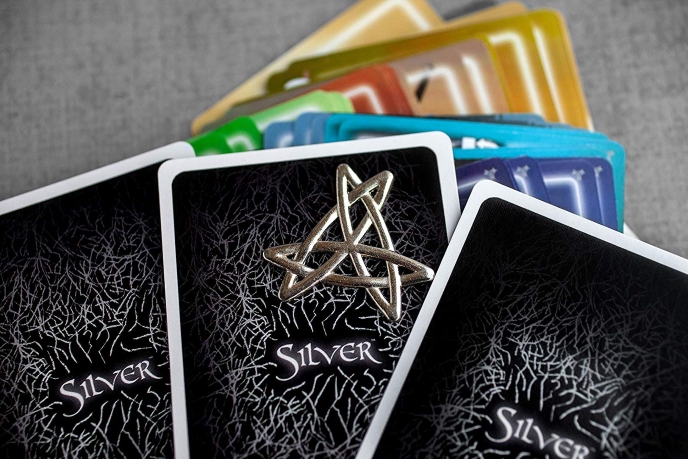Silver, a Card Game in the One Night Ultimate Werewolf Universe, Isn’t Meaty Enough
Images courtesy of Bezier Games Games Reviews board games
Silver is a quick-moving card game that asks players to try to manipulate their hands of five cards to get lower and lower numbers … except that the cards start the game face-down, and you don’t know what your cards are until you draw action cards that let you peek.
A retheme of a small 2010 game called Cabo, which Bézier Games also reissued this year in a new second edition, Silver is set in the same thematic universe as designer Ted Alspach’s One Night Ultimate Werewolf games, with many cards sharing names of characters from the Werewolf boxes, but there’s no tie in game play—this is more a game of memory and strategy, without the social deduction component of the Werewolf titles. In Silver, you start the game with five face-down cards, and can only look at two of them. Your goal is to have the lowest total for the face values of all of your cards whenever the round ends, which will require you to figure out what the rest of your cards are, and then to make a series of exchanges to try to work your total down to a number low enough that you think you might win.
On your turn, you take the top card from the deck and look at it. You can decide to keep it in your village, exchanging it for any one card you already have, or for multiple cards of the same numerical value (that’s important). You can choose to activate its power, if it has one, and then discard it. Or you can simply discard it outright. That’s your entire turn, so downtime between player turns is extremely quick.
The cards in Silver are numbered 0 through 13, and each card has a unique feature, so not all cards are quite created equal—and they’re not all activated in the same way. There are two 0 cards in the deck, and they have no function other than to end the round if both cards are face-up in players’ tableaux (called ‘villages’ in the game). The cards numbered 1 to 4 have ongoing benefits if they’re in your village and face up. The cards numbered 5 to 12, however, are only activated when they’re drawn. These range from simply letting you flip one of your cards face-up, to letting you look at one card anywhere on the table, to letting you switch one of your cards with any card from an opponent’s village. The 13 card, the Doppelgänger, is the high-risk/high-reward card: If you take it, you can match it to any other card in your village in a future exchange, but if you’re stuck with it when the round ends, it counts for 13 points, and you’re probably going to lose just because of that.

The round ends when one player uses their turn to call for a vote, which you’d only do if you thought you had the lowest point total. You can only call for a vote when you have four cards or fewer in your village, so you’ll have to use the exchange feature where you trade in multiple cards with the same face value (or a doppelgänger) to get to do so. At that point, all players reveal the face-down cards in their village and add up the points on all of their cards. If the player who called for the vote had the lowest point total, they get zero points; if they don’t, they get the total of their cards’ points plus a penalty of 10 points. All other players score the total points on their cards. The game goes for four rounds, and players just add their scores for each round, with the player with the lowest total the winner.
Silver is fun with two players, but it’s better with three or four. The Witch card, number 11, is essentially useless in two-player games because the victimized player could just take their discarded card back. It’s also much easier to remember your opponents’ cards when you only have one opponent to track; with more players, it’s still possible, but you’d be trying to remember about 20 cards at a time, and then you’re more likely to forget or just focus on your own village. More players also means more opportunities to use the higher-numbered cards’ actions, while in a two-player game those cards will often just be discarded because there isn’t a good enough move available.
Silver is the first game in a series—this box is technically Silver Amulet, and the second box, with 13 new cards, is Silver Bullet—where you can build a custom deck by combining cards from different boxes, as long as you do one card for each number. The instructions on the cards aren’t always consistent in their use of terms, such as confusing discarding and exchanging, so we went back to the card reference booklet multiple times over the course of a half-dozen plays; I’m hopeful these will be revised or edited in future releases. I’m also not really sure if a character called the Exposer (card number 5) who’s holding his jacket open is cheekily humorous or a bit tacky.
Games take under an hour, and with two players you can rip through a game in under a half hour. There’s a good bit of text on the cards that might slow younger players down, but there are no game concepts here that an 8-year-old who’s played other board games couldn’t grasp. It’s a solid, highly portable game for family play but probably filler for folks who like their games a little meatier.
Keith Law is a senior baseball writer for ESPN.com and an analyst on ESPN’s Baseball Tonight. You can read his baseball content at search.espn.go.com/keith-law and his personal blog the dish, covering games, literature, and more, at meadowparty.com/blog.